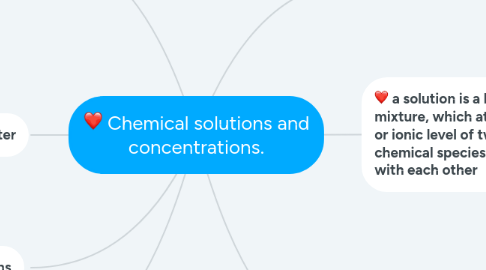Chemical solutions and concentrations.
by leidy prieto

1. This classification does not take into account the numerical amount of solute and solvent present, and depending on the proportion between them they are classified
1.1. Diluted solution: It is one in which the amount of solute involved is in minimal proportion in a given volume
1.2. Concentrated solution: It has a considerable amount of solute in a given volume
1.3. Unsaturated solution: Does not have the maximum possible amount of solute for a given temperature and pressure
2. a solution is a homogeneous mixture, which at the molecular or ionic level of two or more chemical species do not react with each other
2.1. General characteristics
2.1.1. They are homogeneous mixtures
2.1.2. When dissolving a substance, the final volume is less than the sum of the volumes of the solvent and the solute
2.1.3. Its physical properties depend on its concentration: HCl solution (hydrochloric acid) 12 mol / L Density = 1.18 g / cm3 Solution HCl (hydrochloric acid) 6 mol / L Density = 1.10 g / cm3
2.1.4. Its components are joined and the solvent is generated by the process called decontriation.
3. Classification of the solutions
3.1. Solid in Solid: When both the solute and the solvent are in solid state. A clear example of these types of solutions are alloys.
3.2. Solid Gas: As its definition says, it is the mixture of a gas in a solid. An example can be Hydrogen
3.3. Liquid in Solid: When a liquid substance dissolves together with a solid
4. Liquids
4.1. Solids in Liquids: This type of solutions is the most commonly used, since small amounts of solid substances (solutes) are usually dissolved in large liquid amounts (solvents).
4.2. Gases in Liquids: An example is when Oxygen is added in Water.
4.3. Liquids in Liquids: This is another of the most used solutions. In chemistry practices
5. mineral water
5.1. Solids in Gases: There are plenty of solutions of this type, because we can find them in pollution by studying the components of smoke for example, it will be found that there are several minerals dissolved in gases.
5.2. Gases in Gases: Similarly, there is a wide variety of gas solutions with gases in the atmosphere, such as oxygen in nitrogen.
5.3. Liquids in Gases: These types of solutions are found in mists.
6. qualitative solutions
7. Valued Solutions
7.1. Unlike empirical solutions, quantitative valued solutions do take into account the exact numerical amounts of solute and solvent used in a solution. This type of classification is widely used in the field of science and technology, since high precision is very important in them.


